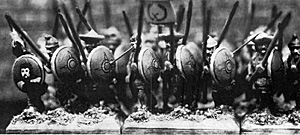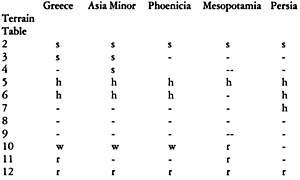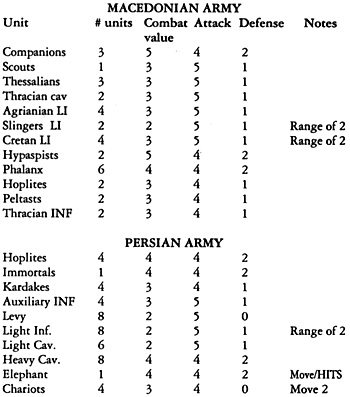 Alexander of Macedon is an introductory type wargame for the
ancient period covering the conquest of the Persian Empire. Though the
rules are simple, the game captures much of the flavor of the period. The
game is played upon a board with miniature figures.
Alexander of Macedon is an introductory type wargame for the
ancient period covering the conquest of the Persian Empire. Though the
rules are simple, the game captures much of the flavor of the period. The
game is played upon a board with miniature figures.
They may not be quite right for the period, but they sure look good : Figures from the collection of Dave Waxtel
The board should be divided into squares as described. The number of figures required is fairly limited and therefore not expensive to field. A variable move/counter move system is employed which with its element of uncertainty should provide a degree of excitement.
Players will notice that the Macedonian army is much more flexible in its ability to maneuver and attack in a coordinated manner, which was the chief advantage it enjoyed over its much more numerous opponent. However, Alexander cannot afford to lose a battle. To do so will cost him the support of some of his reluctant Greek allies. To lose two such battles will cause him to lose the war. The Persians on the other hand can afford to lose several battles.
Eventually, however, they will have to defeat Alexander to save their empire. The campaign will generate a minimum of 4 battles, if Alexander does not lose a battle. A defeat in the first battle will result in a Persian invasion of Greece. The fate of many nations and empires rests in the balance.
The objective for Alexander is to conquer Persia by winning a battle in the strategic space Persia. There are 5 abstract strategic spaces in the campaign:
- 1. Greece-where the Macedonians begin the campaign
2. Asia Minor-where the Persians begin the campaign
3. Phoenicia
4. Mesopotamia
5. Persia
The abstract movement between the strategic spaces always follows the order listed. The sole function of the strategic spaces is to provide the format for the individual battles. Terrain and available forces will be affected by the location of the battles.
 The strategic spaces and related terrain tables are at right.
The strategic spaces and related terrain tables are at right.
The Campaign begins with Alexander's Macedonians moving into Asia Minor, forcing a battle. The loser of a battle will retreat one area backwards If Alexander wins the first battle, the Persians will retreat back to Phoenicia. The winner will then advance in pursuit to force the next battle. Should the Macedonians prove victorious in the battle of Phoenicia, the scene will shift to Mesopotamia for the third battle. A Macedonian victory here will provide for the fourth battle to occur in Persia with a Macedonian campaign victory possible. Except as noted elsewhere, each army is fully restored to full strength for the next battle.
If Alexander loses a battle, he will permanently lose the 2 hoplite units for the rest of the campaign. A second loss results in a Persian victory.
The Persians do not receive Elephants and Chariots in Greece or Asia Minor. In Mesopotamia and Persia, the Persians only receive 2 hoplite units. Instead, they may substitute any 2 other infantry types (4 if levy is chosen).
The battle board consists of 20 spaces wide and 16 spaces deep. Standard poster board of 40" x 32" rules into 2" squares works well for 15mm figures. The attacker (usually the Macedonians) may roll twice on the terrain table, and the defender may roll 4 times. The defender rolls first and places terrain (if any) first. Pieces of terrain may not be superimposed on one another.
H-Hill: Covers two adjoining squares (2" x 4" if using 2 inch squares). Units on a hill add +I to attack dice and subtract -I to defense dice. 2 range attack units may not fire over.
W-Woods: covers 4 spaces in a square (4" x 4" using the two inch squares). Only light infantry may occupy. Subtract -1 from defense dice. 2 range attack units may not fire over.
S-Stream: Runs from any one board edge directly in a straight line to the opposite board edge. Units attacking while in a stream subtract -1 from attack dice. Only one stream may exist in a battle. Other stream terrain results after the first are ignored.
R-River: Runs from any space on the friendly board edge within 3 squares of either flank side in a straight line to the enemy board edge. No unit may enter a river. Only one river result may occur. In effect they provide flank protection and can represent either the Sea or a major river.
NOTE: If using poster board for terrain, other pieces of poster board can be cut to necessary shapes to represent terrain or appropriate models may be used.
The Persian army deploys first on their first 5 rows. The Macedonians may then deploy on their first 5 rows. Only one unit may ever occupy a space.
Using a standard deck of cards with 2 jokers (54 cards), mark the following designations on each card. A black sharpie or magic marker type pen will work well.
- 2 jokers Whole army (macedonian only)
2 red aces Companions + /Scouts
2 red kings Companions /Scouts
2 red queens Companions / Scouts / Thessalians
2 red jacks and Tens Thessalians/ Thracian Cav.
2 red nines Hypaspists / Agrianians / Cretans
2 red eights and sevens Hypaspists / Phalanx
2 red sixes and fives Peltasts /Thracian Inf.
2 red fours Hoplites
2 red threes and twos Agrianians / Cretans Slingers
2 black aces Hoplites / Immortals
2 bl. kings and queens Hoplites / Immortals Kardakes
2 hijacks Auxiliary inf.
2 bltens Levy
2 bl nines and eights Light Infantry
2 b1sevens Elephant
2 bl sixes Chariots
2 bl fives Heavy cav / Light Cav
2 bl fours Heavy cav
2 bl threes Light cav
2 bl twos Light cav / Light Inf.
The cards are shuffled and turned over one at a time to determine the order of movement and attacks. The black cards are only for Persian movement and attacks, while the red cards and jokers are for the Macedonians. The more elite and active type units are given more cards, which results in their being able to do more during the game.
As a card is turned, the designated unit types may move and then attack. Light infantry and light cavalry only may attack first and then move. Moves and attacks are optional, except possibly for the elephant. A '+' on a card indicates that the unit receives an extra die in its attack (if any).
Chariots may move 2 spaces and then attack. All other units may only move one space. No diagonal moves or attacks are allowed. All light infantry except the Agrianians may attack at two space range. Such attacks may be over other units. Attacks may be in any direction.
When attacking, a unit rolls a number of dice equal to its combat value. One hit is scored for each roll >/= its attack number. Modifiers to die rolls may apply as specified. When a defending unit is HIT, it may roll a number of dice equal to its combat value as a saving throw action. A die roll less than/equal its defense number cancels one HIT. Any remaining HITS are marked on the defending unit. They become permanent. Three such permanent hits eliminates a unit (exception, it takes 4 to eliminate the elephant). This process is repeated separately for each attack and its related defense. Therefore each unit attacks separately and its effects are resolved before the next unit performs its attack. A unit defends as often as it is attacked with any HITS resulting.
Unit moves and attacks are performed one unit at a time in any desired order.
When an elephant card is drawn, the Persian makes 4 sequential rolls. An odd Die Roll means the elephant may move one space. For a wounded elephant (one with any hits), the Macedonian may roll a die and if the roll is A battle ends when one side is eliminated or concedes. Play then proceeds to strategic movement for the next battle.
The number of figures in a unit does not affect play, therefore any basing or scale will work as long as all unit types are clearly defined.

Back to Table of Contents -- Courier #62
To Courier List of Issues
To MagWeb Master Magazine List
© Copyright 1993 by The Courier Publishing Company.
This article appears in MagWeb.com (Magazine Web) on the Internet World Wide Web.
Other articles from military history and related magazines are available at http://www.magweb.com